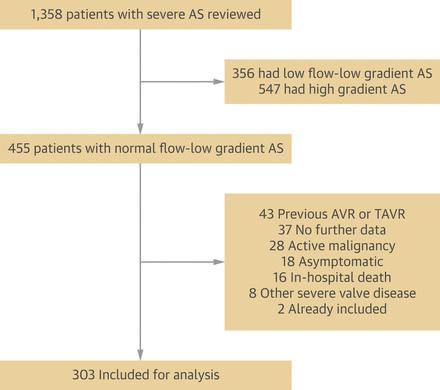JACC: Cardiovascular Imaging ( IF 14.0 ) Pub Date : 2018-09-01 , DOI: 10.1016/j.jcmg.2017.07.020 Oren Zusman , Gregg S. Pressman , Shmuel Banai , Ariel Finkelstein , Yan Topilsky

|
Objectives The purpose of this study was to describe patients with severe symptomatic aortic stenosis with normal flow and low gradients and determine whether they benefit from intervention.
Background Severe symptomatic aortic stenosis is a progressive disease with high mortality. Although surgical aortic valve replacement (SAVR) or transcatheter aortic valve replacement (TAVR) are indicated for patients with high gradients (>40 mm Hg) or low gradients due to low flow, the approach for patients with normal flow and low gradients is poorly defined.
Methods Consecutive adult patients who underwent echocardiography between 2012 and 2015 at Tel-Aviv Medical Center and had an aortic valve area of ≤1.0 cm2, a mean gradient of <40 mm Hg, a stroke volume index of >35 ml/m2, and symptoms formed the study group. Patients designated for intervention (SAVR or TAVR) had their procedure within 6 months of the echocardiogram; the others were treated conservatively. The endpoints were all-cause mortality and cardiac-related mortality.
Results During the study period, 1,358 patients with an aortic valve area of ≤1.0 cm2 and symptoms were identified; 34% of these had normal flow and low gradient aortic stenosis and 303 were included. After mean follow-up of 652 days, 60 patients (20%) had died, with overall mortality rates of 28%, 10%, and 12% for conservatively treated, TAVR, and SAVR patients, respectively (p < 0.001). Using Cox regression with adjustment for other variables, TAVR was associated with improved survival versus conservative treatment (hazard ratio [HR]: 0.49; 95% confidence interval [CI]: 0.26 to 0.93; p = 0.03), and lower cardiac mortality (HR: 0.30; 95% CI: 0.10 to 0.74; p = 0.007) with no significant difference for SAVR versus TAVR. After propensity score matching of TAVR and conservatively treated patients, 25 of 94 (28%) conservatively treated and 10 of 94 (12%) TAVR patients had died (p = 0.016). In the matched cohort, Cox regression showed that TAVR had a significant association with improved survival (HR: 0.42; 95% CI: 0.20 to 0.86; p = 0.03).
Conclusions Symptomatic patients with an aortic valve area of ≤1.0 cm2, normal flow, and low gradient may benefit from intervention as opposed to conservative treatment.
中文翻译:

目的本研究旨在描述具有正常血流和低梯度的严重症状性主动脉瓣狭窄患者,并确定他们是否从干预中受益。
背景严重的症状性主动脉瓣狭窄是一种进展性疾病,死亡率高。尽管对于高梯度(> 40 mm Hg)或由于低流量导致低梯度的患者,建议使用手术主动脉瓣置换(SAVR)或经导管主动脉瓣置换(TAVR),但对于正常流量和低梯度的患者,方法尚不明确。
方法连续成人患者于2012年至2015年在特拉维夫医疗中心接受超声心动图检查,主动脉瓣面积≤1.0cm 2,平均梯度<40 mm Hg,卒中体积指数> 35 ml / m 2,和症状组成了研究组。指定接受干预的患者(SAVR或TAVR)在超声心动图检查后的6个月内进行了手术;其他人则受到保守对待。终点是全因死亡率和与心脏相关的死亡率。
结果在研究期间,主动脉瓣面积≤1.0cm 2的1,358例患者并确定症状;其中34%的人流量正常且主动脉瓣狭窄狭窄,其中303人被纳入研究。平均随访652天后,有60例患者(20%)死亡,保守治疗的TAVR和SAVR患者的总死亡率分别为28%,10%和12%(p <0.001)。使用Cox回归并调整其他变量后,TAVR与生存率和保守治疗相比有所改善(危险比[HR]:0.49; 95%置信区间[CI]:0.26至0.93; p = 0.03)和较低的心脏死亡率(HR) :0.30; 95%CI:0.10至0.74; p = 0.007),SAVR与TAVR无显着差异。在TAVR和保守治疗的患者的倾向评分匹配后,94例保守治疗的25例(28%)和94例TAVR患者的10例(12%)死亡(p = 0.016)。在配对的同类中,
结论主动脉瓣面积≤1.0cm 2,血流正常且梯度低的有症状患者可从介入治疗中受益,而与保守治疗相反。



























 京公网安备 11010802027423号
京公网安备 11010802027423号